Are you ready to dive into more of this five-week project-based learning unit? After the successful launch of our Dinosaur project-based learning unit with a field trip to the Alaska State Fair, it was time for us to learn about the dinosaurs, answer our essential and personal questions, and figure out the answer to our overarching driving question . . . What happened to the dinosaurs?
STEAM Learning Centers
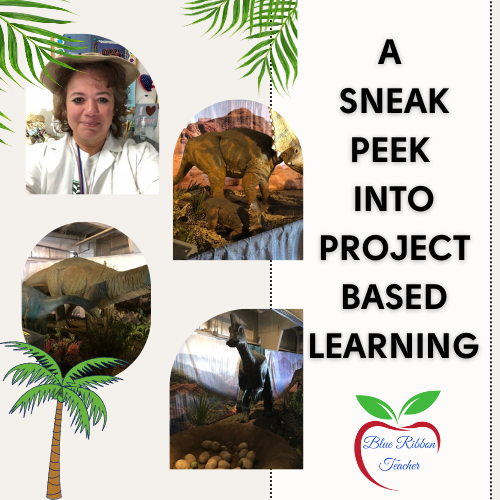
This post may contain affiliate links, and I may earn compensation when you click on the links at no additional cost to you.
The students immersed themselves in nonfiction text, played nonfiction games, enjoyed art projects, tried their hand at problem-solving games, went on a WebQuest excursion, and participated in uncovering fossils at our very own “Dinosaur Mountain Dig”.
A variety of student-led learning tasks and teacher-led lessons were available for students to experience learning in a variety of ways.
My favorite way to design a curriculum is using multiple intelligences and experiential learning pedagogy. This is exactly the format I used for these STEAM Learning Centers.
When my students arrived to school for our learning week, I was dressed as a paleontologist! It was super fun to see their expression when I greeted them at the door. They knew we were in for another fun day – actually 2 weeks – of project-based learning with STEAM. I
In my blended, multi-age classroom, our day begins with students working in their online learning program (personalized learning). I meet one-on-one with students or pull small groups to review, clarify, and/or preteach academic concepts. I also teach specific skills during our afternoon project-based learning time, since I design curriculum to meet student needs.
Starting the Week with Project Based Learning
Once the students entered into the classroom, they couldn’t resist checking out the “Dinosaur Mountain Dig” site. “What are we doing here?” was the question that hummed throughout the morning. I love to add a little excitement and suspense to our learning environment.
STEAM Learning Center Background
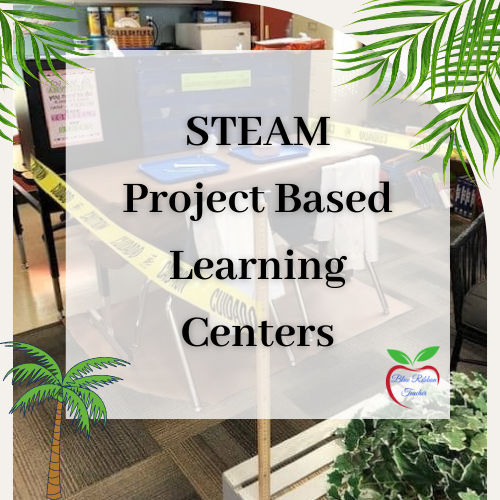
It wasn’t long before I had more questions about our project! They knew we would learn more about dinosaurs, but how were we going to be learning?
By becoming researchers, paleontologists, and artists . . . of course!
I set up the learning using a station rotation format (materials posted at the end of this blog). There were seven stations for students to participate in, gather information, and engage in learning discourse with their peers.
I chose to set up the stations using a variety of learning experiences to fit the diverse learning needs of my students. Students spent about 30 minutes at each station over a two-week station learning period. Towards the end of the two-week timeframe, students had the opportunity to go back to any station he/she felt needed more attention. Check out the station rotation learning below.
STEAM Learning Center with Art and Literacy

Here students work on a dinosaur art project. They water-colored a background first. Then they watched Art Hub for Kids to draw a dinosaur. Here you see students coloring their dinosaurs using oil pastels. Once this piece was done, students adhered the dinosaur to their background and created additional setting items to finish their art project with construction papers.
Since we’ve been studying a variety of dinosaurs, students finished off the project by writing a “How to be a Dinosaur” poem. We attached poems to their artwork and shared these projects with our learning community. This was a great opportunity to embed some art with literacy to demonstrate learning using multiple intelligences.
Researching Dinosaurs to Build Content Knowledge
This is one of the nonfiction games students played and used for learning. You can see the students are writing important information in their Project Based Interactive Notebook (PBIN). When students research, they use a variety of resources – at least 3 – to gather information.
Here are additional learning centers for students to gather information and share learning about a large variety of dinosaurs. The students enjoyed quizzing each other with this card game and learning about dinosaurs. This was a favorite game that students chose to play during free-choice time.

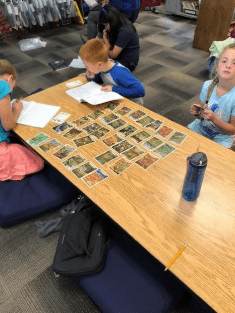
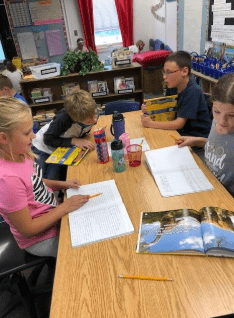
From the research gathered in each learning center, students completed a Process Grid that was located in our Google Classroom. The completed Process Grid was printed off and adhered to their interactive project notebook.
“Dinosaur Mountain Dig” STEAM Learning Center
Over the course of the two weeks, students worked in a variety of centers to work as real researchers and paleontologists. The essential questions were driving our learning centers each day. We debriefed each day to share new learnings and see how our learning was getting us closer to answer our driving question.
The students took their job seriously and worked diligently to discover the ancient fossils. Once all the fossils were discovered, students had to figure out how to put them together and identify the prehistoric animal. An exciting part of our learning was being a paleontologist.

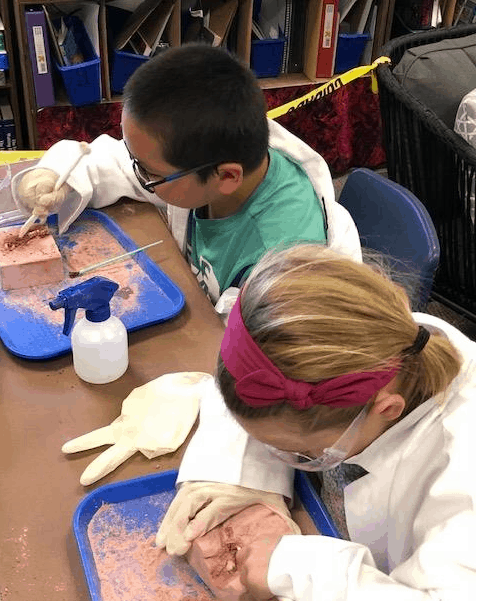
Critical Thinking with STEM Learning Centers
Students engaged in some critical thinking and problem solving centers. Here students must keep the meat and plant eaters on separate islands.
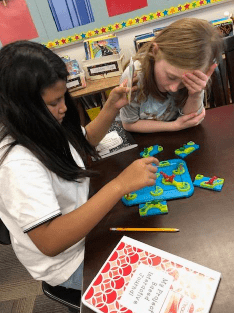
Following the clues on the card, students worked to solve the problem. There are three different levels to challenge every student.
I set out a card for each level, so students could decide which level they felt ready to accomplish.
This allows students to challenge him/herself making this challenge their choice.
WebQuest
Another learning center focused on students engaging in a WebQuest that I created. The WebQuest was placed on my classroom website, so students could work on the project at school and at home. Besides reading additional information, I included some videos to view and games to play so students had a variety of technological resources available to support their learning. In my classroom, I use flexible seating options. These choices allow students to get comfortable and learn in a way that supports each individual.

As you can see, these learning experiences were quite diverse and allowed students to learn at a variety of instructional and cognitive levels that occurred over a two week period. Giving students time to use a variety of learning resources and opportunities to learn in ways that are unique to the learner is an important part of my classroom.
While our learning centers operated in the afternoon, I took some time in the morning to provide direct instruction working with other dinosaur nonfiction texts. Literary skills included: nonfiction conventions, note-taking skills, determining text importance, outlining, concept mapping, and highlighting important text. Students took three quizzes and a test over the five-week unit.
Related Resources for STEAM Project-Based Learning Unit
This post is the second in a series of four. The other posts are shared below.
A Day in the Life of a Paleontologist
STEM Learning Lab: Dino Egg Drop
What is 21st Century Pedagogy?
Below are some resources I used for the Dino STEAM learning stations. Click on the picture to go the Amazon purchase page.
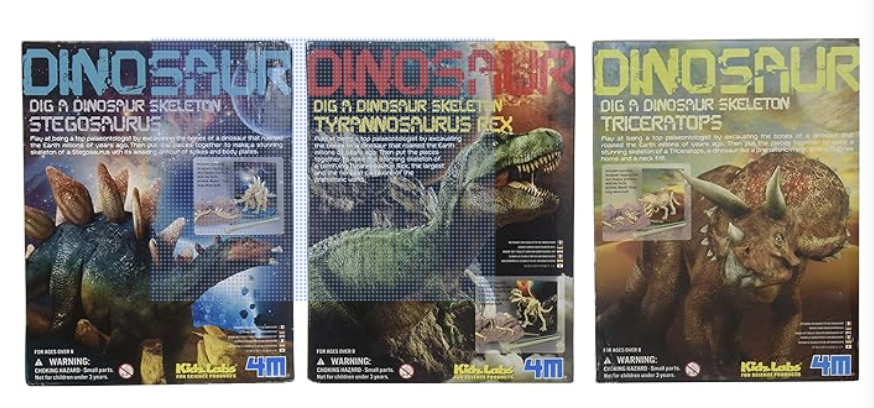

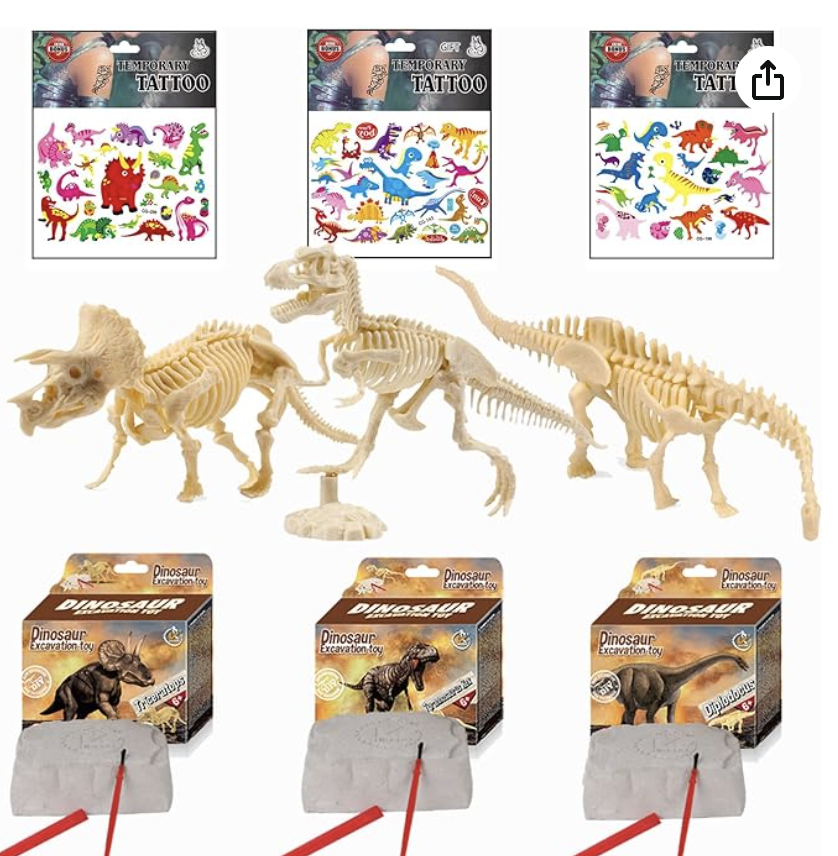
Final Thoughts
This project-based learning unit had a variety of centers focusing on all aspects of STEAM: science, technology, engineering, art, and math. Each of the students had a variety of learning options and various ways to demonstrate learning. Each of these components is part of a student-centered instructional classroom. The students were fully engaged and motivated to learn using these stations. Check out the related posts for even more ideas to coordinate with this instructional focus.

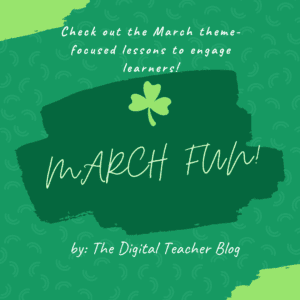

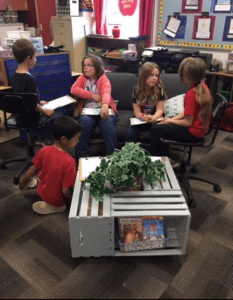
I love how you share your creativity with your students and with us!! Looks like you have fun with them.
T.M, I’m glad you can take part in our learning. If I am not having fun, I know the kids are not having fun (and likely not learning). I do enjoy working with these kids and learning with them.
Thanks for following our journey!!
~ Annette
What a fabulous set up! You’ve set up an amazing learning environment!
Thank you, Dennis! I certainly love seeing these students LOVE learning. All the “extras” are totally worth the learning experience.
~ Annette
What a fun learning experience! I bet those kids will always remember it!
I agree, Carmen. Providing learning experiences that include an emotional connection stays in the memory part of the brain. I hope they look back upon their learning in 10, 20, 30 years, and truly say they had a fabulous learning experience while working with me.
~Annette
My kids love dinosaurs and would like doing something interactive like this. I find this to be the best way to learn.
Monica, I agree with your thoughts. It is so much more fun to “engage” in learning. I’m sure your “dinosaur kiddos” would love to learn this way, too.
~ Annette
I used to love doing units like this. They are so enjoyable for everyone involved. Love that it can hit all types of learners.
I agree, Karie! Planning units to support ALL learners can be challenging. However, once the “masterpiece” is put together with tweaks along the way and lots of reflection . . . a series of superb learning experiences happen.
Thanks for stopping by!
~ Annette
That looks like so much fun! Science is so much better when its hands on!
I agree, Kathryn!! Kids love to engage in science, social studies, and art. Their eyes just light up with excitement and they become sponges ready to learn anything! I love teaching with these instructional methods.
Thanks for stopping by!
~ Annette
As a retired teacher, I think you have a really fun classroom with hands on activities! Love this!
Thank you, Laura! Your comment means a lot, as you know the work that goes into planning, implementing, assessing, and reflecting on these learning experiences.
Thank you!
~ Annette
Annette, I absolutely love this post! So, is your school all about project-based learning (is this how your curriculum is written), or is this something you tend to do as an individual? It looks like so much fun. I bet your students can’t wait to get to school to see what you have up your sleeve! Great work & great post as well!
Thank you, Mary! My class was a pilot classroom last year, and I am in year 2 using online learning coupled with project based learning. My class is 1 of 5 elementary classrooms in my district (there are 40 elementary schools) using this model. My district is closely analyzing data to see the effectiveness, and so far, the achievement is impressive (this also aligns with the research). It is an exciting time to be in education. After teaching 25 years in a traditional classroom, I am sooo blessed to have this opportunity in my school. My kids absolutely LOVE coming to school. They LOVE science, social studies, and art. Teaching literacy and math through these venues (cross curricular instruction) just brings my room to life. This teaching is A LOT of work, but soooo worth it – for the kids and me!
Thanks for stopping by!
~ Annette
This looks so amazing. I love this style of interactive learning, and my kids always enjoyed it as well.
Thank you, Jennifer!! The kids certainly love the interaction, cooperative learning, and hands on experiences.
~ Annette
This looks like you all had so much fun! Great post, Having fun while learning is an awesome way to learn.
Thanks, Rosanna!! I know the kids had just as much fun as I did. The best part . . . they were learning!
~ Annette